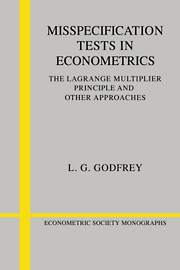Book contents
- Frontmatter
- 1 Approaches to testing the hypothesis of adequate specification
- 2 Inequalities between criteria for testing hypotheses in linear regression models
- 3 The Lagrange multiplier test and testing for misspecification: an extended analysis
- 4 Tests for misspecification of regression equations
- 5 Tests for misspecification of simultaneous equation models
- 6 Tests for qualitative and limited dependent variable models
- Bibliography
- Index
1 - Approaches to testing the hypothesis of adequate specification
Published online by Cambridge University Press: 05 January 2013
- Frontmatter
- 1 Approaches to testing the hypothesis of adequate specification
- 2 Inequalities between criteria for testing hypotheses in linear regression models
- 3 The Lagrange multiplier test and testing for misspecification: an extended analysis
- 4 Tests for misspecification of regression equations
- 5 Tests for misspecification of simultaneous equation models
- 6 Tests for qualitative and limited dependent variable models
- Bibliography
- Index
Summary
Introduction
Tests for misspecification play an important role in the evaluation of econometric models, and the need for such tests has been stressed by several authors. For example, Hendry (1980, p. 403) suggests that the three golden rules of econometrics are 'test, test and test,' and Malinvaud (1981, p. 1370) argues that the research aims of econometricians should include the special requirement that more emphasis be put on the testing of the specification. One purpose of this chapter is to consider some basic issues in testing for specification error. These issues, which are discussed in Sections 1.2 and 1.3, include the arguments for and against employing an alternative specification when testing the model under scrutiny, the interpretation of test statistics and their potential value in respecification following the rejection of a tentatively entertained model.
Some of the available statistical procedures and the relationships between them are also discussed at a rather general level in preparation for the detailed examination of tests of particular interest to economists and econometricians which appears in subsequent chapters. A large part of this discussion is presented in Section 1.4, which focuses on the likelihood ratio, Wald and Lagrange multiplier tests (sometimes referred to collectively as the trinity of classical tests). The emphasis on these three tests is justified in part by the fact that they are widely used in econometrics. Also a detailed discussion of these procedures makes it simpler to examine related tests that are potentially useful, but less familiar to applied workers; several such procedures are considered in Section 1.5.
- Type
- Chapter
- Information
- Misspecification Tests in EconometricsThe Lagrange Multiplier Principle and Other Approaches, pp. 1 - 42Publisher: Cambridge University PressPrint publication year: 1989



